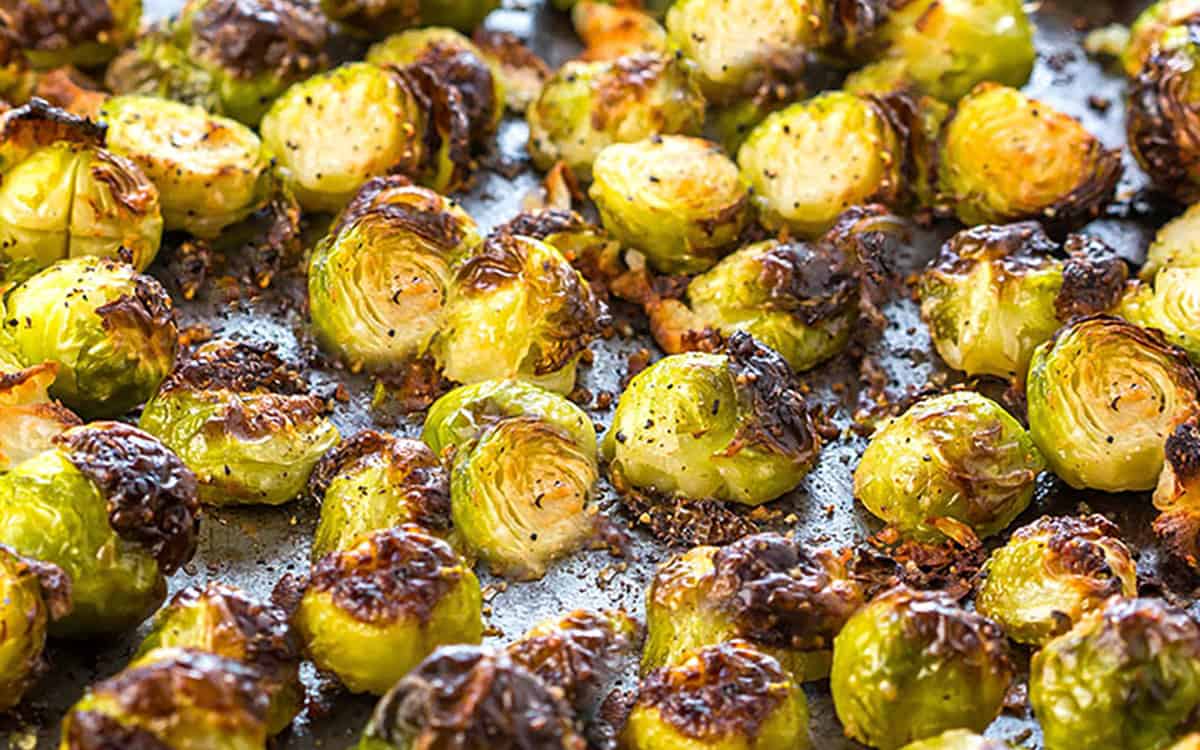If there is one thing the team at Trost Financial Consulting has in common with each other, more than the pure joy we get from working with our clients, it is our love of good food! Each team member chose their favorite holiday recipe to share with our clients and friends. We hope you enjoy them as much as we do.
Carrie Geist loves this super easy Roast Chicken recipe
Reprinted from Bouchon, by Thomas Keller, Copyright © 2004, published by Artisan.

YIELD 2–4 servings
INGREDIENTS
-
- One 2- to 3-pound farm-raised chicken
- Kosher salt and freshly ground black pepper
- 2 teaspoons minced thyme (optional)
- Unsalted butter
- Dijon mustard
Preparation
- Preheat the oven to 450°F. Rinse the chicken, then dry it very well with paper towels, inside and out. The less it steams, the drier the heat, the better.
- Salt and pepper the cavity, then truss the bird. Trussing is not difficult, and if you roast chicken often, it’s a good technique to feel comfortable with. When you truss a bird, the wings and legs stay close to the body; the ends of the drumsticks cover the top of the breast and keep it from drying out. Trussing helps the chicken to cook evenly, and it also makes for a more beautiful roasted bird.
- Now, salt the chicken—I like to rain the salt over the bird so that it has a nice uniform coating that will result in a crisp, salty, flavorful skin (about 1 tablespoon). When it’s cooked, you should still be able to make out the salt baked onto the crisp skin. Season to taste with pepper.
- Place the chicken in a sauté pan or roasting pan and, when the oven is up to temperature, put the chicken in the oven. I leave it alone—I don’t baste it, I don’t add butter; you can if you wish, but I feel this creates steam, which I don’t want. Roast it until it’s done, 50 to 60 minutes. Remove it from the oven and add the thyme, if using, to the pan. Baste the chicken with the juices and thyme and let it rest for 15 minutes on a cutting board.
- Remove the twine. Separate the middle wing joint and eat that immediately. Remove the legs and thighs. I like to take off the backbone and eat one of the oysters, the two succulent morsels of meat embedded here, and give the other to the person I’m cooking with. But I take the chicken butt for myself. I could never understand why my brothers always fought over that triangular tip—until one day I got the crispy, juicy fat myself. These are the cook’s rewards. Cut the breast down the middle and serve it on the bone, with one wing joint still attached to each. The preparation is not meant to be super elegant. Slather the meat with fresh butter. Serve with mustard on the side and, if you wish, a simple green salad. You’ll start using a knife and fork, but finish with your fingers, because it’s so good.
Toni Kriley is sharing her Secret Brussels Sprouts recipe!

Yield: 4+ side servings
Ingredients
- 4 to 6 slices of bacon or pancetta (cured belly)
- 2 cloves of garlic peeled and finely chopped
- ½ small yellow onion chopped
- 1 pound fresh brussels sprouts trimmed and halved
- 1 to 2 tablespoons amber maple syrup
- Black pepper to taste
Optional
- Red pepper flakes
- 2 tablespoons chevre goat cheese, or my personal favorite, Humboldt Fog goat cheese
Preparation
- Cook bacon or pancetta in a large skillet over medium-high heat, turning occasionally, until evenly browned, about 10 minutes. Drain on paper towels, leaving grease in the skillet.
- Toss onions in bacon grease in skillet for about 2 minutes then add brussels sprouts. Turn the heat down to medium low and put a lid on for about 2-3 minutes.
- Take the lid off and turn the heat back up to medium high and add garlic. Sauté for 2 minutes.
- Add bacon (chopped) season with black pepper and red pepper flakes. Optional; add syrup. Let cook together for 1 minute, DO NOT overcook!
- Finish with goat cheese if preferred. I like to put little dollops on the top of the finished dish.
Even the biggest carnivore will become a fan of these brussels sprouts.
Jim Watson is excited to share his mouthwatering Prime Rib Roast cooked to a perfect medium rare and smothered in a compound butter spiced with chili powder, cumin, fresh herbs, and garlic. Perfect for any holiday or special occasion.
Prime Rib Roast – By Jo Cooks

Prep Time 10 minutes
Cook time 1 hour, 30 minutes
Rest time 20 minutes
Ingredients
Compound Butter
- 8 tbsp butter unsalted, room temperature (1/2 cup or 1 stick)
- 2 tsp chili powder I used a mild chili powder
- 1 tsp cumin ground 1 tbsp thyme chopped, fresh
- 1 tbsp rosemary chopped, fresh
- 3 cloves garlic minced
- 1 tsp salt or to taste
- 1 tsp pepper or to taste
- 5 lb prime rib
Prime Rib Roast
- 2 medium onions quartered
- 5 cloves garlic peeled
- 4 sprigs thyme
- 2 sprigs rosemary
Gravy
- 1 cup dry red wine
- 1 cup beef broth low sodium
- 1 tbsp cornstarch
- 2 tbsp water
Instructions
- Remove your roast from all its packaging and let it sit out at room temperature for one to two hours. Also make sure your roast is fully thawed, you do not want to cook a roast from frozen. Using paper towels, pat the roast completely dry.
- Preheat your oven to 450 F degrees for at least 30 minutes, while the prime rib comes to room temperature.
- In a bowl mix the butter with the chili powder, cumin, thyme, rosemary, garlic, salt, and pepper until well combined.
- With either a spatula or your hands, spread the compound butter mixture over the entire roast.
- Place the onions, garlic, thyme and rosemary in a large skillet that will fit your roast. If you don’t have a large enough skillet, use a roasting pan.
- Place the roast over the onions in the skillet.
- Cook the roast for 15 minutes at 450 F degrees, then reduce the oven temperature to 325 degrees. Continue to cook the roast until your meat thermometer reads 120 degrees. Estimate about 15 minutes of cooking time per pound of prime rib.
- Once the thermometer hits 120 F degrees, remove the roast from the oven and transfer it to a cutting board. Cover it with aluminum foil and let it rest for 20 minutes. The roast will continue to cook as the juices inside settle, raising the internal temperature to 130 degrees for a perfect medium-rare prime rib.
- Slice and serve with gravy over mashed potatoes.
Gravy
- While to roast is resting, place the skillet with the onions, garlic and herbs over medium high heat.
- Add the red wine and beef broth and bring to a boil. Lower the heat and simmer for about 5 minutes. The sauce should reduce a bit.
- Mix the 1 tbsp of cornstarch with 2 tbsp of water and to the skillet. Whisk it and continue to cook for a few more minutes. The sauce should thicken. Use more cornstarch if wanting a thicker gravy.
- Strain into a bowl, then pour it into a gravy boat.
Notes
- Nutritional information assumes 2 servings per pound.
Michael Mora enthusiastically offers up this Potato Latke recipe

Ingredients
- 2 1/2 pounds baking potatoes, peeled and coarsely shredded on a box grater
- 1 medium onion, coarsely shredded on a box grater
- 2 large eggs, beaten
- 1/2 cup finely chopped scallions
- 1/4 cup matzo meal
- 3 tablespoons unsalted butter, melted and cooled slightly
- 2 teaspoons kosher salt
- 1/2 teaspoon black pepper
- 1/2 teaspoon baking powder
- Vegetable oil, for frying
- Applesauce, sour cream, smoked salmon and salmon roe, for serving
Directions
- In a colander set over a large bowl, toss the potatoes with the onion and squeeze dry. Let the potatoes and onion drain for 2 to 3 minutes, then pour off the liquid in the bowl, leaving the starchy paste at the bottom. Add the potatoes and onion, along with the eggs, scallions, matzo meal, butter, salt, pepper and baking powder; mix well.
- In a large skillet, heat an 1/8-inch layer of oil until shimmering. Spoon 1/4-cup mounds of the latke batter into the skillet about 2 inches apart and flatten slightly with a spatula. Fry the latkes over moderately high heat, turning once, until golden and crisp, 5 to 7 minutes. Transfer the latkes to paper towels to drain, then transfer to a platter. Repeat to make the remaining latkes, adding.more oil to the skillet as needed. Serve with applesauce, sour cream, smoked salmon and salmon roe
Greg Trost President and Founder of Trost Financial Consulting is sharing his favorite recipe from the cooking class at Sur La Table last year.
Courtesy of Chef Michelle H at Sur La Table, Los Angeles
Perfect Buttermilk Mashed Potatoes

Yield: 8 to 10 servings
The russet potato, also known as the baking or Idaho potato, has low moisture and high starch, qualities that yield wonderfully light and fluffy mashed potatoes. The key to that fluffy texture is to process the hot potatoes in a ricer or food mill. It’s also important to simmer rather than boil potatoes for even cooking.
Ingredients
- 5 pounds russet potatoes, peeled and cut into 1-inch chunks
- 1 tablespoon plus 2 teaspoons sea salt, divided
- 1 cup heavy whipping cream
- 1 cup whole milk
- 2/3 cup buttermilk
- 4 ounces (1 stick) unsalted butter, cut into 1/2-inch pieces
- Freshly ground black pepper
- To prepare the potatoes: To a large pot, add the potatoes and cover with 2 inches of cold water. Bring to a boil over high heat and add 1 tablespoon of salt. Lower heat to medium, cover partially, and simmer until potatoes are tender and can be pierced with a fork with little to no resistance, 15 to 20 minutes. Drain potatoes in a colander.
- While potatoes are cooking, to a small saucepan set over medium-low heat, add cream, milk, buttermilk, butter, and remaining 2 teaspoons salt. Cook until butter is melted, 3 to 4 minutes. Remove from heat.
- To make the mashed potatoes: Set a potato ricer on the rim of the pot used to cook potatoes. Fill the ricer halfway with cooked potatoes and press them through. Continue until all the potatoes have been riced.
- Fold a little bit of the cream mixture at a time into the riced potatoes, using a silicone spatula, until desired consistency is reached. Taste and adjust seasoning with salt and pepper.
- To serve:Mound potatoes in a warmed serving bowl and serve immediately. (Potatoes can be made a few hours ahead, dotted with 1 tablespoon butter, loosely covered with foil, and kept in a warm oven.)




